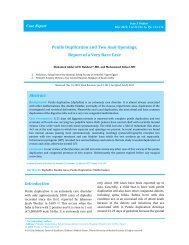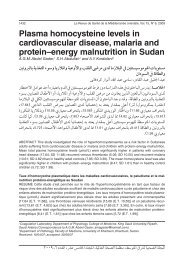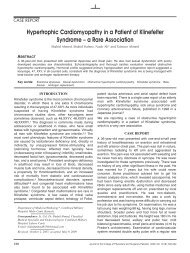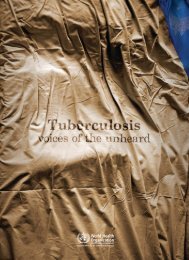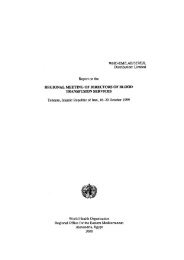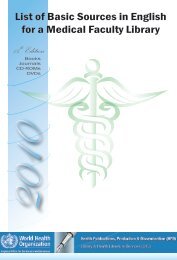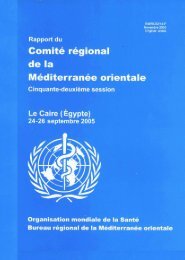Autoclaved Gelatin (Haemagel) Versus 6% Hydroxyethyl Starch 200 ...
Autoclaved Gelatin (Haemagel) Versus 6% Hydroxyethyl Starch 200 ...
Autoclaved Gelatin (Haemagel) Versus 6% Hydroxyethyl Starch 200 ...
Create successful ePaper yourself
Turn your PDF publications into a flip-book with our unique Google optimized e-Paper software.
Alexandria Journal of Anaesthesia and Intensive Care<br />
<strong>Autoclaved</strong> <strong>Gelatin</strong> (<strong>Haemagel</strong>) <strong>Versus</strong> <strong>6%</strong> <strong>Hydroxyethyl</strong> <strong>Starch</strong><br />
<strong>200</strong>/0.5 (Haes-steril) For Plasma Volume Expansion In Critically-ill<br />
Patients<br />
Magdy Ali Omera, MD * , Salah A. Ismail, MD *<br />
* Assistant Prof. of Anaesthesia, Faculty of Medicine, Suez Canal University.<br />
ABSTRACT<br />
Synthetic colloids are used to optimize hemodynamics in the critically ill patients and a<br />
debate about the most suitable one is still present. The influence of short term infusion of<br />
autoclaved gelatin (<strong>Haemagel</strong>) and <strong>6%</strong> hydroxyethyl starch <strong>200</strong>/0.5 (Haes-steril) on<br />
hemodynamic, respiratory, coagulation, renal and oncotic parameters were examined in a<br />
prospective randomized study.<br />
Method: Thirty patients suffering from systemic hypoperfusion due to sepsis in ICU of Suez<br />
Canal University Hospital were assigned into 2 equal groups. In GEL group: 1000 ml of<br />
<strong>Haemagel</strong> was infused within an hour, while in HES group: 1000 ml of <strong>6%</strong> Haes-steril<br />
<strong>200</strong>/0.5 was given within an hour. The hemodynamic, respiratory, hematological,<br />
coagulation, renal and colloidal osmotic pressure parameters were recorded before and after<br />
infusion of both colloids.<br />
Results: There was a significant similar increase in hemodynamic variables (Mean arterial<br />
pressure, central venous pressure, cardiac index, stroke volume index and left ventricular<br />
stroke work index) in both groups. Also, a significant improvement in tissue perfusion as<br />
judged by decreased arterial lactate was found. There were no significant differences in any<br />
of the measured respiratory parameters (respiratory rate, arterial oxygen saturation, arterial<br />
blood gases and intrapulmonary shunt) in the studied groups. No significant intergroup<br />
difference in any haemodynamic or respiratory variable was demonstrated. A significant<br />
expansion in plasma volume as indicated by the significant reduction in haematocrit was<br />
detected. There were insignificant changes in coagulation profile (prothrombin time,<br />
activated partial thromboplastin time, bleeding time and fibrinogen) in either group except the<br />
platelet count which was significantly reduced in both groups without any recorded bleeding<br />
complications. Creatinine, blood urea nitrogen, sodium and potassium didn't change and<br />
were comparable in the two groups. Colloidal osmotic pressure and urine output increased<br />
significantly in either group. Anaphylactic reactions were not observed in any of the patients.<br />
However, no significant differences between both groups in haematological, coagulation,<br />
renal and oncotic parameters were found.<br />
Conclusion: Both autoclaved gelatin (<strong>Haemagel</strong>) and <strong>6%</strong> hydroxyethyl starch <strong>200</strong>/0.5<br />
(Haes-steril) are safe and equally effective colloids for plasma volume expansion in critically<br />
ill patients without apparent adverse effects on respiration, coagulation and renal functions.<br />
INTRODUCTION<br />
In critically-ill patients, acute circulatory<br />
failure is often associated with<br />
intravascular volume depletion which<br />
contributes to inadequate cardiac output,<br />
tissue hypoperfusion, and development of<br />
multiple organ failure (1) . Replacement of<br />
intravascular deficit remains the most<br />
important therapeutic maneuver in management<br />
of those patients to ensure adequate<br />
cardiac output (2) . Whilst crystalloids<br />
are virtually free of major side effects,<br />
they don ' t necessarily ensure adequate<br />
volume replenishment or hemodynamic<br />
AJAIC-Vol. (8) No. 2 June <strong>200</strong>5<br />
44<br />
stabilization. There are several studies<br />
showing the advantages of colloid solution<br />
over crystalloid volume replacement (3,4)<br />
and a debate about the choice of specific<br />
colloid is still present (5) . Although the<br />
naturally occurring colloidal agent (albumin)<br />
is effective for fluid resuscitation, it is also<br />
very expensive with the potential risk of<br />
infection (6) . Dextran has not been widely<br />
used because it might result in increased<br />
bleeding, allergic reaction, possible renal<br />
toxicity and problems with blood crossmatching<br />
(7) .
Alexandria Journal of Anaesthesia and Intensive Care<br />
<strong>Hydroxyethyl</strong> starch (HES), a synthetic<br />
colloid with a high volume expanding<br />
effect, is produced by hydroxylation of<br />
the starch amylopectin. HES (<strong>200</strong>/0.5)<br />
has a molecular weight (<strong>200</strong>,000 D)<br />
which allows rapid elimination by kidney<br />
(8) . It also has a low molar substitution<br />
ratio (0.5) making it more rapidly and<br />
completely degraded by circulating<br />
amylase with less tissue retention (8) .<br />
Since HES has the fewest<br />
anaphylactoid reactions among the<br />
artificial colloids, it is the most comm.only<br />
clinically used colloid (9) . However,<br />
large doses of this solution may<br />
increase bleeding by inducing coagulopathy<br />
through an effect on factor VIII<br />
activity (8, 10-12) .<br />
Different colloid solutions containing<br />
gelatin have been developed. Collagen<br />
is degraded via both a thermal effect<br />
producing oxypolygelatin (OPG), and an<br />
enzymatic effect producing either<br />
modified fluid gelatin (Gelofusine), or<br />
urea cross-linked gelatin (Haemaccel),<br />
while double degradation and autoclaving<br />
producing (<strong>Haemagel</strong>). <strong>Haemagel</strong><br />
is a balanced salt gelatin-based<br />
colloidal solution (100 mL contains 4 g<br />
gelatin). It has a higher half-life, no<br />
pseudo agglutination, and no possible<br />
contamination (13) . Although researchers<br />
have studied gelatin for volume<br />
replacement, its safety and efficacy<br />
have not been fully investigated (14-18) .<br />
So, this study compared autoclaved<br />
gelatin (<strong>Haemagel</strong>) with <strong>6%</strong> hydroxylethyl<br />
starch <strong>200</strong>/0.5 (Haes-steril) in term<br />
of efficacy and safety as a short term<br />
volume expander in critically-ill patients.<br />
PATIENTS AND METHODS<br />
After approval of the local ethics<br />
committee and an informed consent<br />
from each patient or his/her family, thirty<br />
critically-ill patients in ICU of Suez Canal<br />
University Hospital suffering from systemic<br />
hypoperfusion due to sepsis were<br />
enrolled in this study. Inclusion criteria<br />
were patients who required fluid therapy<br />
AJAIC-Vol. (8) No. 2 June <strong>200</strong>5<br />
45<br />
on a clinical ground in the presence of<br />
sepsis and systemic hypo-perfusion.<br />
Sepsis was diagnosed, in addition to<br />
positive blood culture, by the presence<br />
of 3 of the following 5 criteria;<br />
tachycardia (HR >100 beat/min), tachypnea<br />
(RR >25 breath/min), temperature<br />
(>38 0 C or 15,000 or 100 mg/dl), cerebral hemorrhage,<br />
patients having PT >18 sec, aPTT >45<br />
sec, fibrinogen < 150 mg/dl or Hct
Alexandria Journal of Anaesthesia and Intensive Care<br />
heart rate (HR), core temperature<br />
(Temp), respiratory rate (RR), arterial<br />
oxygen saturation (SaO2) and noninvasive<br />
mean arterial blood pressure<br />
(MAP) measurement through a continuous<br />
display (S/5, Datex Ohmeda, Instrumentation<br />
Corp, Finland).<br />
Baseline data were recorded before the<br />
start of infusion;<br />
A] Patient characteristics: Age, sex,<br />
weight, height, body surface area (BSA),<br />
temperature and clinical diagnosis.<br />
B] Hemodynamic parameters: HR,<br />
MAP, CVP, CI, SVI, LVSWI and SVRI<br />
were measured in supine position.<br />
C] Respiratory data: RR, SaO2, arterial<br />
blood gases [pH, arterial oxygen tension<br />
(PaO2), arterial carbon dioxide tension<br />
(PaCO2), bicarbonate (HCO3)] and<br />
intrapulmonary shunt [obtained through<br />
ABL 520 Radiometer].<br />
D] Hematological and coagulation<br />
parameters: Haematocrit (Hct), platelet<br />
count, prothrombin time (PT), activated<br />
partial thromboplastin time (aPTT),<br />
bleeding time (BT) and fibrinogen (22) .<br />
E] Renal function and electrolytes: Urine<br />
output (UOP), serum creatinine, blood<br />
urea nitrogen (BUN), serum sodium<br />
(Na + ) and potassium (K + ) (22) .<br />
F] Colloidal osmotic pressure (COP)<br />
and arterial lactate (AL) were also<br />
measured.<br />
Using a randomized sequence, the<br />
patients were prospectively assigned to<br />
one of the following groups:<br />
1) Group (GEL): where 1000 ml of<br />
<strong>Haemagel</strong> (each 100 ml contains:<br />
<strong>Autoclaved</strong> gelatin 4 g, glycine 1 g, NaCl<br />
0.859 g, KCl 0.0389 g and CaCl 0.029<br />
g, Vacsera, Holding company for<br />
biological products and vaccines, Egypt)<br />
was infused during an hour.<br />
2) Group (HES): where 1000 ml of <strong>6%</strong><br />
Haes-steril (HES <strong>200</strong>/0.5, MW <strong>200</strong>,000,<br />
DS 0.5, Fresenius Kabi, Bad Hamburg,<br />
Germany) was infused during an hour.<br />
After the end of infusion, all the previous<br />
parameters were recorded again by a<br />
AJAIC-Vol. (8) No. 2 June <strong>200</strong>5<br />
46<br />
physician not involved in the study and<br />
who was blind to the grouping.<br />
All results are expressed as means ±<br />
SD. The change in different parameters<br />
compared to the baseline values was<br />
analyzed using paired t-test. The<br />
difference between the two groups was<br />
assessed by one way analysis of variant<br />
(ANOVA). A p value
Alexandria Journal of Anaesthesia and Intensive Care<br />
both groups. In addition, there was a<br />
significant decrease in platelet count in<br />
GEL and HES groups. However, no<br />
significant differences between both<br />
groups in any hematological or coagulation<br />
parameter were detected (table<br />
4).<br />
Renal function and electrolytes<br />
Urine volume increased significantly<br />
after infusion of both colloids without<br />
significant differences between both<br />
groups. Creatinine, BUN and electrolytes<br />
(Na + and K + ) were not changed<br />
and were comparable in both groups<br />
(table 5).<br />
Colloidal osmotic pressure<br />
In both groups, the baseline COP<br />
was within normal range (more than 18<br />
mmHg). After infusion, there was a<br />
significant increase in both groups<br />
without intergroup differences (table 6).<br />
No allergic reactions or bleeding<br />
complications were recorded in any<br />
studied patient<br />
DISCUSSION<br />
Hypovolemia is a common clinical<br />
occurrence in severe sepsis and fluid<br />
resuscitation remains one of the most<br />
important interventions. However, it is<br />
AJAIC-Vol. (8) No. 2 June <strong>200</strong>5<br />
47<br />
still uncertain which solution is most<br />
suitable for fluid resuscitation in these<br />
patients (9) . The goal in fluid resuscitation<br />
is to maintain an effective intravascular<br />
blood volume, subsequently, enhancing<br />
cardiac output, oxygen delivery and<br />
tissue perfusion (1,2,6) . However, to achieve<br />
these goals, attempts are tried to<br />
minimize possible deterioration in<br />
pulmonary, renal and other system<br />
functions.<br />
The aim of this study was to<br />
compare the effect of short-term infusion<br />
of autoclaved gelatin and <strong>6%</strong> hydroxylethyl<br />
starch on hemodynamic, respiratory,<br />
hematologic, coagulation, renal<br />
and oncotic pressure variables in a<br />
controlled prospective manner.<br />
In the present study, MAP, CVP, CI,<br />
SVI and LVSWI were significantly<br />
increased in both groups. While SVRI<br />
and AL were significantly decreased,<br />
HR did not change significantly during<br />
the study. However, no significant<br />
differences between the studied groups<br />
in these parameters were found. The<br />
improvement in these hemodynamic<br />
variables and arterial lactate levels are<br />
always associated with favorable<br />
prognosis in critically-ill patients (1, 2) .<br />
Table 1: Demographic data in both <strong>Haemagel</strong> (GEL) and Haes-steril (HES)<br />
groups.<br />
Parameter<br />
Age (years)<br />
Sex ( M/F)<br />
Weight (kg)<br />
BSA (m 2 )<br />
Temperature ( 0 C)<br />
GEL group<br />
55 ± 11<br />
7/8<br />
73 ± 12<br />
1.88 ± 0.20<br />
37.3 ± 0.4<br />
Number of patients<br />
15<br />
Diagnosis: Pneumonia<br />
6<br />
Peritonitis<br />
6<br />
Urinary infection<br />
3<br />
Data are represented as means ± SD unless otherwise noted.<br />
M = Male, F = Female, BSA = Body surface area.<br />
HES group<br />
53 ± 13<br />
8/7<br />
75 ± 10<br />
1.86 ± 0.23<br />
38.0 ± 0.3<br />
15<br />
7<br />
6<br />
2
Alexandria Journal of Anaesthesia and Intensive Care<br />
Table 2: Hemodynamic and arterial lactate changes in both <strong>Haemagel</strong> (GEL)<br />
and Haes-steril (HES) groups.<br />
Parameter<br />
Group Baseline data Post infusion data<br />
HR (beat/min)<br />
GEL<br />
100 ± 7<br />
99 ± 8<br />
HES<br />
102 ± 5<br />
103 ± 7<br />
MAP (mmHg)<br />
GEL 62.2 ± 2.7<br />
74.3 ± 5.1*<br />
HES 60.5 ± 7.6<br />
73.1 ± 4.3*<br />
CVP (cmH2O)<br />
GEL<br />
5.6 ± 1.4<br />
9.3 ± 1.5*<br />
HES<br />
4.8 ± 1.9<br />
8.5 ± 1.3*<br />
CI (L/min.m GEL<br />
2.2 ± 0.3<br />
3.5 ± 0.6*<br />
HES<br />
2.3 ± 0.2<br />
3.5 ± 0.4*<br />
2 )<br />
SVI (ml/m GEL 29.0 ± 6.6<br />
37.5 ± 3.8*<br />
HES 27.7 ± 3.1<br />
35.5 ± 4.6*<br />
2 )<br />
LVSWI (gm.m/m GEL 20.8 ± 3.6<br />
35.6 ± 3.3*<br />
HES 21.6 ± 5.4<br />
35.2 ± 4.2*<br />
2 )<br />
SVRI (dyne.sec/cm GEL 1861 ± 149 1558 ± 246*<br />
HES 1978 ± 222 1660 ± 234*<br />
5 .m 2 )<br />
AL (mmol/L)<br />
GEL<br />
2.7 ± 1.6<br />
1.4 ± 1.2*<br />
HES<br />
2.9 ± 1.4<br />
1.5 ± 1.5*<br />
Data are presented as means ± SD.<br />
*A significant difference within each group compared to baseline P < 0.05.<br />
HR = Heart rate, MAP = Mean arterial pressure, CVP = Central venous pressure, CI<br />
= Cardiac index, SVI = Stroke Volume index, LVSWI = Left ventricular stroke work<br />
index, SVRI = Systemic vascular resistance index, AL = Arterial lactate.<br />
Table 3: Respiratory changes in both <strong>Haemagel</strong> (GEL) and Haes-steril (HES)<br />
groups.<br />
Parameter<br />
Group Baseline data Post infusion data<br />
RR (breath/min)<br />
GEL<br />
20.0 ± 2<br />
19.0 ± 3<br />
HES<br />
22.0 ± 4<br />
21.0 ± 3<br />
SaO2 (%)<br />
GEL<br />
96.0 ± 1.7<br />
97.1 ± 1.3<br />
HES<br />
97.5 ± 0.5<br />
98.6 ± 0.7<br />
pH<br />
GEL 7.33 ± 0.06 7.37 ± 7.34 ± 0.05 7.38 ±<br />
HES<br />
0.03<br />
0.02<br />
PaO2 (mmHg)<br />
GEL<br />
88.0 ± 16<br />
90.0 ± 12<br />
HES<br />
86.0 ± 18<br />
88.0 ± 14<br />
PaCO2 (mmHg)<br />
GEL<br />
33.0 ± 2.7<br />
35.0 ± 2.3<br />
HES<br />
36.0 ± 1.5<br />
38.0 ± 2.0<br />
HCO3 (mmol/L)<br />
GEL<br />
19.3 ± 2.3<br />
20.0 ± 1.7<br />
HES<br />
17.9 ± 1.5<br />
18.4 ± 1.4<br />
Qs/Qt (%)<br />
GEL<br />
16.5 ± 3<br />
17.1± 5<br />
HES<br />
18.3 ± 4<br />
19.0 ± 5<br />
Data are presented as means ± SD and percentage.<br />
RR = Respiratory rate, SaO2 = Arterial oxygen saturation, PaO2 = Arterial oxygen<br />
tension, PaCO2 = Arterial carbon dioxide tension, HCO3 = Bicarbonate and Qs/Qt =<br />
Intra-pulmonary shunt fraction.<br />
AJAIC-Vol. (8) No. 2 June <strong>200</strong>5<br />
48
Alexandria Journal of Anaesthesia and Intensive Care<br />
Table 4: Hematologic and coagulation changes in both <strong>Haemagel</strong> (GEL) and<br />
Haes-steril (HES) groups.<br />
Parameter<br />
Group Baseline data Post infusion data<br />
Hct (%)<br />
GEL 38.8 ± 3.4<br />
30.2 ± 3.2*<br />
HES 36.9 ± 2.8<br />
29.5 ± 4.7*<br />
PT (sec)<br />
GEL 14.7 ± 0.5<br />
15.0 ± 0.8<br />
HES 13.9 ± 1.2<br />
14.4 ± 0.6<br />
aPTT (sec)<br />
GEL 35.7 ± 3.3<br />
37.2 ± 3.1<br />
HES 38.5 ± 2.9<br />
39.8 ± 2.4<br />
BT (min)<br />
GEL<br />
6.2 ± 0.4<br />
6.4 ± 0.2<br />
HES 5.8 ± 0.6<br />
6.0 ± 0.3<br />
Fibrinogen (mg/dl) GEL<br />
300 ± 88<br />
295 ± 64<br />
HES 320 ± 77<br />
310 ± 45<br />
Platelets (1000/mm GEL<br />
<strong>200</strong> ± 48<br />
150 ± 86*<br />
HES 210 ± 55<br />
150 ± 37*<br />
3 )<br />
Data are presented as means ± SD.<br />
*A significant difference within each group compared to baseline P < 0.05.<br />
Hct = Hematocrit, PT = Prothrombin time, aPTT = Activated partial thromboplastin<br />
time, BT = Bleeding time.<br />
Table 5: Electrolytes and renal changes in both <strong>Haemagel</strong> (GEL) and Haessteril<br />
(HES) groups.<br />
Parameter<br />
Group Baseline data Post infusion data<br />
UOP (ml/h)<br />
GEL 50 ± 15<br />
90 ± 20*<br />
HES 55 ± 10<br />
95 ± 15*<br />
Creatinine (mg/dl) GEL 1.2 ± 0.4<br />
1.3 ± 0.2<br />
HES 1.3 ± 0.5<br />
1.3 ± 0.3<br />
BUN (mg/dl)<br />
GEL 20.5 ± 2.3<br />
20.1 ± 1.5<br />
HES 22.2 ± 1.4<br />
21.8 ± 1.9<br />
Na GEL 138 ± 6<br />
137 ± 5<br />
HES 136 ± 9<br />
136 ± 7<br />
+ (mmol/L)<br />
K GEL 3.9 ± 0.4<br />
4.0 ± 0.2<br />
HES 4.1 ± 0.2<br />
4.1 ± 0.6<br />
+ (mmol/L)<br />
Data are presented as means ± SD.<br />
*A significant difference within each group compared to baseline P < 0.05.<br />
UOP = Urine output, BUN = Blood urea nitrogen, Na + = Sodium, K + = Potassium.<br />
Table 6: Changes in colloidal osmotic pressure (mmHg) in both <strong>Haemagel</strong><br />
(GEL) and Haes-steril (HES) groups.<br />
Group<br />
Baseline data Post infusion data<br />
GEL<br />
19.6 ± 1.1<br />
22.1 ± 1.4*<br />
HES<br />
18.5 ± 1.5<br />
21.2 ± 1.2*<br />
Data are presented as means ± SD.<br />
*A significant difference within each group compared to baseline P
Alexandria Journal of Anaesthesia and Intensive Care<br />
better normalization of the hypoxic<br />
gastric mucosal acidosis with Gelofusine<br />
(15)<br />
rather than HES. Beyer et al ,<br />
compared <strong>6%</strong> HES <strong>200</strong>/0.5 with<br />
Gelofusine for volume replacement in<br />
patients undergoing orthopedic surgery.<br />
They studied the effect of either colloid<br />
on hemodynamic, colloidal osmotic<br />
pressure and blood clotting. Equivalent<br />
hemodynamic effects were found<br />
without alteration of coagulation profile.<br />
Molnar et al (23) investigated the short<br />
term cardio-respiratory effects of 250 ml<br />
Gelofusine versus 250 ml HES <strong>200</strong>/0.6<br />
in patients with septic shock and acute<br />
lung injury. They found significant<br />
increases in CI and O2 delivery in both<br />
groups with insignificant differences in<br />
extra vascular lung water (no interstitial<br />
or pulmonary edema).<br />
The respiratory and blood gas<br />
parameters did not change significantly<br />
in both groups and were similar during<br />
the study. Consistent results were<br />
demonstrated in previous studies (2, 6) .<br />
Also, Ritto et al (16) showed no changes<br />
in arterial blood gases after Gelofusine<br />
or HES infusion, with no shunt affection.<br />
Expansion of plasma volume as<br />
indicated by the significant decrease in<br />
hematocrit was similar in both groups.<br />
Both colloids have been shown to cause<br />
a slight insignificant prolongation in PT,<br />
aPTT and BT in addition to an<br />
insignificant decrease in fibrinogen. This<br />
could be attributed to hemodilution<br />
which in another previous study (24) , was<br />
proven to be dose related. There was a<br />
significant decrease in platelet count<br />
without significant change in bleeding<br />
time in any group of the current study.<br />
The present work showed neither<br />
significant differences between the two<br />
colloids with respect to coagulation<br />
parameters, nor bleeding complications.<br />
Several previous researches studied the<br />
influence of hydroxyethyl starch and<br />
gelatin on coagulation and bleeding<br />
parameters (10,11,17,24-29) . Fries et al (10)<br />
analyzed the influence of different<br />
AJAIC-Vol. (8) No. 2 June <strong>200</strong>5<br />
50<br />
colloids (<strong>6%</strong> HES 130/0.4, <strong>6%</strong> HES<br />
<strong>200</strong>/0.5 and Gelofusine) on the<br />
coagulation system using Rotation<br />
Thrombelastography (ROTEG). They<br />
found that Gelofusine had the lowest<br />
effect on coagulation. Haisch et al (11)<br />
examined the influence of HES 130/0.4<br />
versus Gelofusine on coagulation and<br />
hemodynamic data in patients undergoing<br />
major abdominal surgery, where<br />
both colloids were effective with<br />
insignificant changes in coagulation<br />
variables or blood loss. The effect of<br />
progressive in vitro hemodilution on<br />
coagulation was measured by<br />
SONOCLOT (17) , where HES showed the<br />
largest impact on markers of<br />
coagulation compared with gelatin or<br />
lactated Ringer's solution. In an<br />
experimental study (25) , HES infusion in<br />
excess of 20 ml /kg was associated with<br />
an increase in bleeding time, thrombin<br />
time together with a decrease in platelet<br />
count and serum fibrinogen. Also, Van<br />
Wyk et al (26) did not find any evidence<br />
that haemaccel affects haemostasis;<br />
neither does it increase bleeding relative<br />
to Ringer's lactate in plasma expansion<br />
during reduction mammoplasty. In<br />
addition, Amany et al (27) showed only<br />
minor effects on clotting variables and<br />
platelet aggregation compared to <strong>6%</strong><br />
HES <strong>200</strong>/0.5, even at doses more than<br />
20 ml/Kg /day in patients undergoing<br />
major abdominal surgery. On the<br />
contrary, limited data suggest that<br />
gelatin based solutions may affect<br />
coagulation (28, 29) .<br />
The significant increase in UOP was<br />
probably due to increased blood volume<br />
in both groups. Creatinine, BUN, Na +<br />
and K + did not change significantly and<br />
were comparable in both groups<br />
indicating insignificant effects on kidney<br />
functions. These results are consistent<br />
with Vogt et al study (12) . In contrast,<br />
Amany et al found that creatinine<br />
clearance was significantly decreased in<br />
HES group compared to <strong>Haemagel</strong><br />
group (27) .
Alexandria Journal of Anaesthesia and Intensive Care<br />
Colloidal osmotic pressure (COP)<br />
could be a desirable goal in volume<br />
replacement because it maintains<br />
normal extravascular water content in<br />
many organs (1, 6) . Profound reduction in<br />
COP may reduce left ventricular<br />
compliance, increase pulmonary extravascular<br />
water content and decrease<br />
tissue oxygen delivery (19) . In this study<br />
GEL and HES were effective in<br />
maintaining COP without significant<br />
differences between both groups. This<br />
was also documented by several studies<br />
where plasma volume and colloid<br />
osmotic pressure were maintained even<br />
in septic shock with capillary leak (30-32) .<br />
In fact, no allergic reactions to either<br />
colloid were observed in any patient of<br />
the present study. This is agrees with<br />
previous researches on either colloid<br />
where extremely low incidence of such<br />
reaction was reported (9, 33) .<br />
In conclusion, autoclaved gelatin<br />
(<strong>Haemagel</strong>) showed similar efficacy and<br />
safety as <strong>6%</strong> hydroxyethyl starch<br />
<strong>200</strong>/0.5 (Haes-steril) for plasma volume<br />
expansion in critically ill patients. Both<br />
solutions improved the hemodynamic<br />
responses and tissue perfusion without<br />
apparent adverse effects on respiration,<br />
coagulation, and renal functions. A<br />
further study may be required to<br />
evaluate the effects of prolonged<br />
administration or larger doses of this<br />
gelatin solution (<strong>Haemagel</strong>) in critically<br />
ill patients.<br />
REFERENCES<br />
1. Hankeln K, Radel C, Beez M, et al.<br />
Comparison of hydroxyethyl starch and<br />
lactated Ringer's solution on<br />
hemodynamics and oxygen transport of<br />
critically ill patients in prospective<br />
crossover studies. Crit Care Med 1989;<br />
17: 133.<br />
2. Rackow EC, Mecher C, Astiz ME, et al.<br />
Effects of pentastarch and albumin<br />
infusion on cardio-respiratory function<br />
and coagulation in patients with severe<br />
sepsis and systemic hypo-tension. Crit<br />
Care Med 1989; 17:394.<br />
AJAIC-Vol. (8) No. 2 June <strong>200</strong>5<br />
51<br />
3. Nagy KK, Davis J, Duda J, et al. A<br />
comparison of pentastarch and lactated<br />
Ringer's solution in the resuscitation of<br />
patients with hemo-rrhagic shock. Circ<br />
Shock 1993; 40:289.<br />
4. Olthof CG, de Vries JP, de Vries PM, et<br />
al. The influence of Ringer's lactate and<br />
gelatin infusion on the internal fluid<br />
balance of healthy volunteers measured<br />
by a non-invasive conductivity<br />
technique. Eur J Anaesth 1993; 10:397.<br />
5. Boldt J, Müller M, Heesen M, et al.<br />
Influence of different volume thera-pies<br />
on platelet function in the critically ill.<br />
Intensive Care Med 1997; 23:709.<br />
6. Boldt J, Heesen M, Müller M, et al. The<br />
effects of albumin versus hydro-xyethyl<br />
starch on cardio-respiratory and<br />
circulatory variables in critically ill<br />
patients. Anesth Analg 1996; 83:254.<br />
7. Petroianu GA, Jie Liu, Maleck WH, et al.<br />
The effect of in vitro hemo-dilution with<br />
gelatin, dextran, hydro-xyethyl starch, or<br />
Ringer's solution on<br />
Thrombelastography. Anesth Analg<br />
<strong>200</strong>0; 90:795.<br />
8. Boldt J, Haisch B, Suttner S, et al.<br />
Effects of a new modified, balanced<br />
hydroxyethyl starch preparation<br />
(Hextend) on measures of coagula-tion.<br />
Br J Anaesth <strong>200</strong>2; 89:722.<br />
9. Laxenaire M C, Mertes P, et al.<br />
Anaphylaxis during anaesthesia:<br />
Results of two-years survey in France.<br />
Br J Anaesth <strong>200</strong>1; 87: 549.<br />
10. Fries D, Innerhofer P, Klinger A, et al.<br />
The effects of the combined<br />
administration of colloids and lactated<br />
Ringer's solution on the coagulation<br />
system: An in vitro study using<br />
thrombelastograph ® coagula-tion<br />
analysis (ROTEG ® ). Anesth Analg <strong>200</strong>2;<br />
94:1280.<br />
11. Haisch G, Boldt J, Krebs C, et al. The<br />
influence of intravascular volume<br />
therapy with a new hydro-xyethyl starch<br />
preparation [<strong>6%</strong> HES 130/0.4] on<br />
coagulation in patients undergoing<br />
major abdominal surg-ery. Anesth Analg<br />
<strong>200</strong>1; 92:565.<br />
12. Vogt NH, Bothner U, Lerch G, et al.<br />
Large-dose administration of <strong>6%</strong><br />
hydroxyethyl starch <strong>200</strong>/0.5 for total hip<br />
arthroplasty: Plasma homeo-stasis,<br />
hemostasis, and renal func-tion
Alexandria Journal of Anaesthesia and Intensive Care<br />
compared to use of 5% human albumin.<br />
Anesth Analg 1996; 83:262.<br />
13. Evans PA, Heptinstall S, Crowhurst EC,<br />
et al. Prospective double-blind<br />
randomized study of the effects of four<br />
intravenous fluids on platelet function<br />
and hemostasis in elective hip surgery.<br />
J Thromb Haemost <strong>200</strong>3; 1:2140.<br />
14. Beards SC, Watt T, Edwards JD, et al.<br />
Comparison of the hemodynamic and<br />
oxygen transport responses to modified<br />
fluid gelatin (Gelofusine) and heta starch<br />
in critically ill patients: A prospective<br />
randomized trial. Crit Care Med 1994;<br />
22: 600.<br />
15. Asfar P, Kerkeni N, Labadie F, et al.<br />
Assessment of hemodynamic and<br />
gastric mucosal acidosis with modi-fied<br />
fluid gelatin versus <strong>6%</strong> hydro-xyethyl<br />
starch: A prospective, rando-mized<br />
study. Intensive Care Med <strong>200</strong>0;<br />
26:1282.<br />
16. Beyer R, Harmening U, Rittmeyer O, et<br />
al. Use of modified fluid gelatin and<br />
hydroxyethyl starch for colloidal volume<br />
replacement in major orthopedic<br />
surgery. Br J Anaesth 1997; 78:44.<br />
17. Ritto D, Gosling P, Burnley S, et al.<br />
Randomized study comparing the<br />
effects of hydroxyethyl starch solu-tion<br />
with gelofusine on pulmonary function in<br />
patients undergoing abdominal aortic<br />
aneurysm surgery. Br J Anaesth <strong>200</strong>4;<br />
92:61.<br />
18. Konard C, Markl T, Schuepfer G, et al.<br />
The effects of in vitro hemo-dilution with<br />
gelatin, hydroxyethyl starch, and<br />
lactated Ringer's solution on markers of<br />
coagulation: An analy-sis using<br />
SONOCLOT . Anesth Analg 1999;<br />
88:483.<br />
19. Balk RA. Severe sepsis and septic<br />
shock: Definitions, epidemiology, and<br />
clinical manifestations. Crit Care Clin<br />
<strong>200</strong>0; 16: 179.<br />
20. Tonnessen T, Tollofsrud S, Kongsgaard<br />
UE, et al. Colloid osmotic pressure of<br />
plasma replacement fluids. Acta<br />
Anaesthesiol Scand 1993; 37: 424.<br />
21. Bernstein DP. Continuous non-invasive<br />
real time monitoring of stroke volume<br />
and cardiac output by electrical thoracic<br />
bioimpedance. Crit Care Med 1986; 14:<br />
898.<br />
AJAIC-Vol. (8) No. 2 June <strong>200</strong>5<br />
52<br />
22. Jacobs DS, De Mott WR, Strobel SL<br />
and Fody EP. Chemistry. In: Labo-ratory<br />
Test Handbook. Jacobs DS, Kasten BL,<br />
De Mott WR, Wolfson WL (eds) Lexi<br />
Company Incorpora-tion, Ohio, (2 nd ed.)<br />
1990; 4 : 358-63.<br />
23. Molnar Z, Mikor A, Leiner T, et al. Fluid<br />
resuscitation with colloids of different<br />
molecular weight in septic shock.<br />
Intensive Care Med <strong>200</strong>4; 30:1356.<br />
24. Claes Y, Van Hemelrijck J, Van Gerven<br />
M, et al. Influence of hydroxyethyl starch<br />
on coagulation in patients during the<br />
perioperative period. Anesth Analg<br />
1992; 75:24.<br />
25. Thompson WL, Gadsen RH. Pro-longed<br />
bleeding times and hypo-fibrinogenemia<br />
in dogs after infusion of hydroxylethyl<br />
starch and dextran. Transfusion 1965; 5:<br />
440.<br />
26. Van Wyk V, Marais A, Diedericks J, Van<br />
der Walt E, et al. Plasma volume<br />
expansion with Haemaccel does not<br />
impair haemostasis during reduction<br />
mammoplasty. Afr J Surg 1998; 36:22.<br />
27. Amany K El-Saway, Wael M R Sakr and<br />
Ismail A Shafik. <strong>Haemagel</strong> 4% versus<br />
hydroxyethyl starch <strong>6%</strong>: Effect on blood<br />
coagulation, hemo-stasis, renal<br />
functions and platelet aggregation in<br />
patients undergoing major abdominal<br />
surgery. Med J Cairo Univ <strong>200</strong>4; 72 (1)<br />
Suppl: 99.<br />
28. Mardel SN, Saunders F, Ollerenshaw L,<br />
et al. Reduced quality of in vitro clot<br />
formation with gelatin-based plasma<br />
substitutes. Lancet 1996; 347: 825.<br />
29. Evans PA, Garnett M, Boffard K, et al.<br />
Evaluation of the effect of colloid<br />
(Haemaccel) on the bleeding time in the<br />
trauma patient. J R Soc Med 1996;<br />
89:101P.<br />
30. Marx G, Cobas Meyer M, Shuerholz, et<br />
al. <strong>Hydroxyethyl</strong> starch and modi-fied<br />
fluid gelatin maintain plasma volume in<br />
a porcine model of septic shock with<br />
capillary leakage. Intensive Care Med<br />
<strong>200</strong>2; 28: 629.<br />
31. Upadhyay M, Singhi S, Murlidharan J, et<br />
al. Randomized evaluation of fluid<br />
resuscitation with crystalloid (saline) and<br />
colloid (polymer from degraded <strong>Gelatin</strong><br />
in saline) in pediatric septic shock.<br />
Indian Pediatr <strong>200</strong>5; 42:223.
Alexandria Journal of Anaesthesia and Intensive Care<br />
32. Kohler H, Zchiedrich H, Clasen R, et al.<br />
Blood volume, colloidal osmotic<br />
pressure and renal function in<br />
volunteers after infusion of middlemolecular<br />
10% hydroxyethyl starch<br />
<strong>200</strong>/0.5 and 10% dextran 40.<br />
Anaesthesist 1989; 38: 1.<br />
AJAIC-Vol. (8) No. 2 June <strong>200</strong>5<br />
53<br />
33. Kimme P, Jannsen B, Ledin T, et al.<br />
High incidence of pruritis after large<br />
doses of hydroxyethyl starch (HES)<br />
infusions. Acta Anaesthesiol Scand<br />
<strong>200</strong>1; 45: 686.



